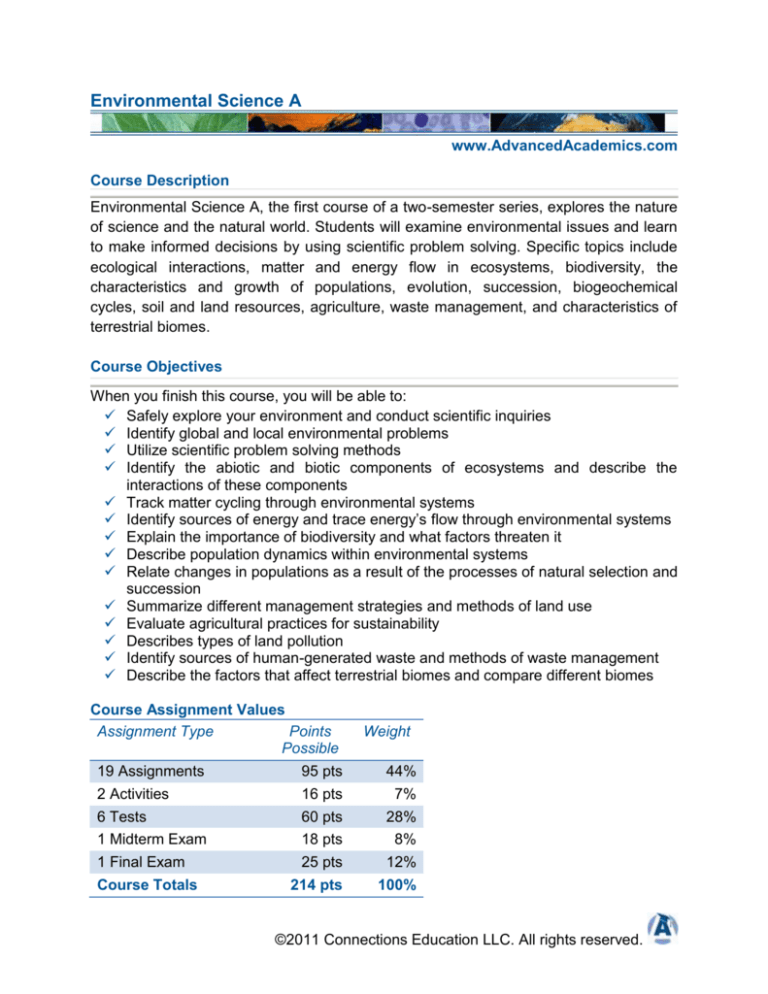
Environmental Science A
www.AdvancedAcademics.com
Course Description
Environmental Science A, the first course of a two-semester series, explores the nature
of science and the natural world. Students will examine environmental issues and learn
to make informed decisions by using scientific problem solving. Specific topics include
ecological interactions, matter and energy flow in ecosystems, biodiversity, the
characteristics and growth of populations, evolution, succession, biogeochemical
cycles, soil and land resources, agriculture, waste management, and characteristics of
terrestrial biomes.
Course Objectives
When you finish this course, you will be able to:
Safely explore your environment and conduct scientific inquiries
Identify global and local environmental problems
Utilize scientific problem solving methods
Identify the abiotic and biotic components of ecosystems and describe the
interactions of these components
Track matter cycling through environmental systems
Identify sources of energy and trace energy’s flow through environmental systems
Explain the importance of biodiversity and what factors threaten it
Describe population dynamics within environmental systems
Relate changes in populations as a result of the processes of natural selection and
succession
Summarize different management strategies and methods of land use
Evaluate agricultural practices for sustainability
Describes types of land pollution
Identify sources of human-generated waste and methods of waste management
Describe the factors that affect terrestrial biomes and compare different biomes
Course Assignment Values
Assignment Type
Points
Possible
Weight
19 Assignments
2 Activities
95 pts
16 pts
44%
7%
6 Tests
60 pts
28%
1 Midterm Exam
18 pts
8%
1 Final Exam
25 pts
12%
214 pts
100%
Course Totals
©2011 Connections Education LLC. All rights reserved.
Suggested Course Schedule
The suggested time frame shown below is based on learning sessions. A learning
session is a 45-minute period of time. This course should take approximately 90
learning sessions to complete, but this schedule is just a suggestion. You may work on
each unit at your own pace, completing as many learning sessions as you’d like in one
sitting. However, keep in mind that you must finish the entire course within the time
specified by your school district.
Learning
Session
1-15
16-30
31-45
Content Covered
Unit 1: Nature of Science
In this unit, you will be introduced to the study of environmental science.
You will learn that it is a broad discipline and develop an understanding
of how environmental scientists work. You will identify environmental
problems and review a brief summary of environmental history. Finally,
you will have an opportunity to reflect on what you already know about
the environment.
In this unit, there will be:
3 Assignments
15 pts
1 Activity
8 pts
1 Unit Test
10 pts
Unit 2: Living in the Biosphere
In this unit, you will be introduced to ecology. Ecology is the study of how
organisms interact with each other and with their environments. You will
learn about ecosystems and factors affecting what type of organisms live
there. You will also differentiate species’ roles in the ecosystem and
classify species according to these roles.
In this unit, there will be:
3 Assignments
15 pts
1 Unit Test
10 pts
Unit 3: Populations and How They Change
Populations are groups of organisms of the same species. Do you know
what species you are and how it has changed over time? What type of
growth is the human species experiencing? In this unit you will examine
these questions and how our growth affects the world community that we
live in.
©2011 Connections Education LLC. All rights reserved.
46-60
61-75
76-90
In this unit, there will be:
3 Assignments
15 pts
1 Unit Test
10 pts
Environmental Science A Midterm Exam 18 pts
Unit 4: Soil and Land Resources
In this unit, you will examine biogeochemical cycles and identify the
characteristics of soil. You will also compare renewable and
nonrenewable resources and investigate different methods by which
these resources are managed.
In this unit, there will be:
3 Assignments
15 pts
1 Activity
8 pts
1 Unit Test
10 pts
Unit 5: Food, Agriculture, and Waste
When you ate breakfast this morning, did you consider what nutrients
were in your food? Do you know where the food came from and how it
was produced? Where does the trash that you generated from breakfast
go? In this unit you will take a closer look at these questions and learn
about the environmental issues associated with them. This unit will also
discuss management processes that could lead to a sustainable future.
In this unit, there will be:
3 Assignments
15 pts
1 Unit Test
10 pts
Unit 6: Terrestrial Biomes
In this unit, you will examine the factors that affect land biomes. You will
see how the climate determines what types of plants grow in a biome and
how plants and animals adapt to limiting factors in their environment. You
will also learn how humans have contributed to habitat degradation and
what habitat restoration involves.
In this unit, there will be:
4 Assignments
20 pts
1 Unit Test
10 pts
Environmental Science A Final Exam 25 pts
Privacy Policy
No member of the Advanced Academics staff is authorized to release student
information without the written permission of the student’s parent or legal guardian.
©2011 Connections Education LLC. All rights reserved.
Names, images, and/or class work of Advanced Academics students will not be
published in print, video/film, or on our public website without written student and
guardian consent.
Disability Statement
If you have a disability or condition that may affect your ability to succeed in this course,
please contact your teacher. It’s important that you discuss the problem with him or her
so accommodations may be made to give you every opportunity to perform well. Your
teacher and virtual school program coordinators are committed to helping students with
disabilities succeed, and every request will be treated with respect and confidentiality.
©2011 Connections Education LLC. All rights reserved.





